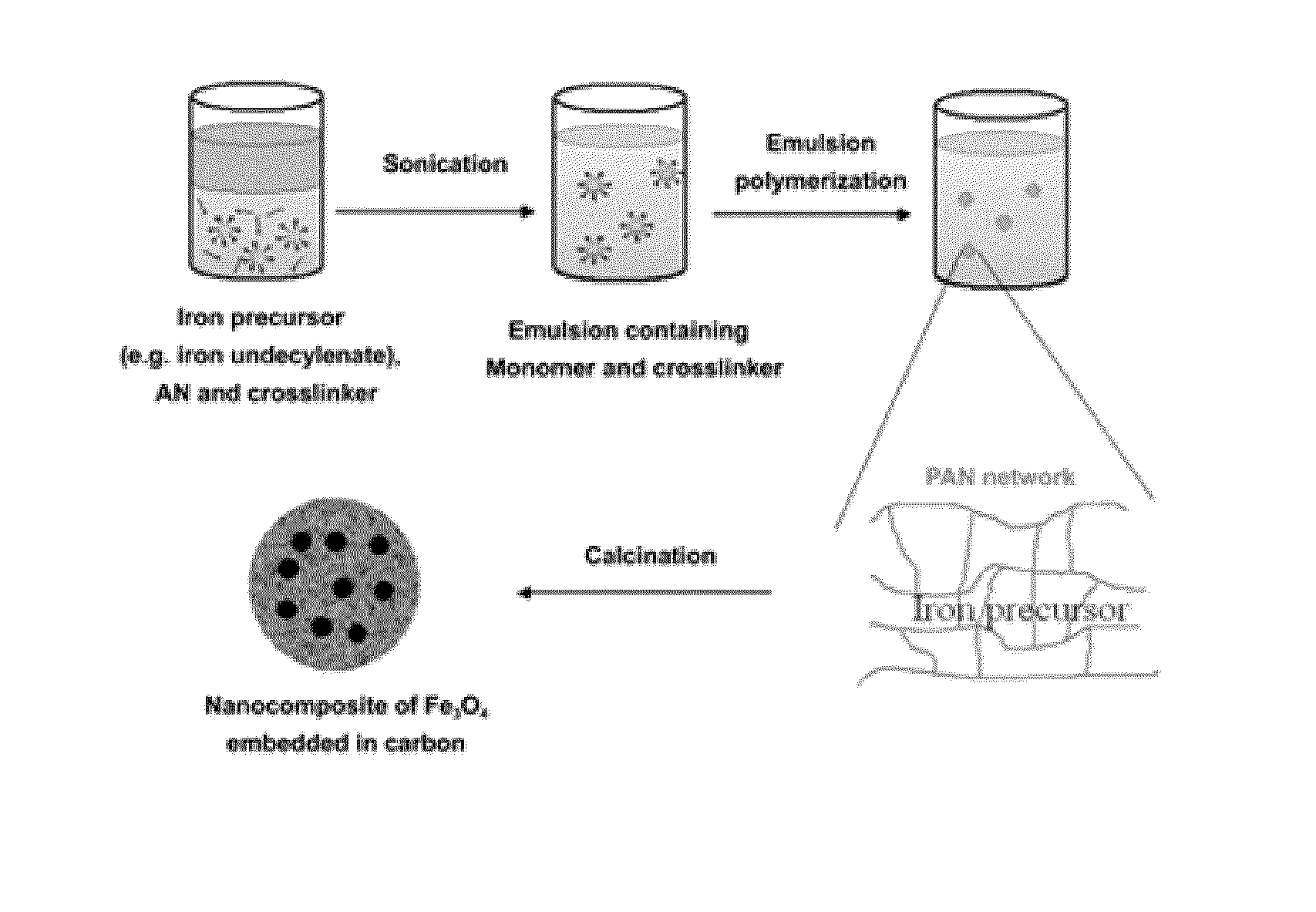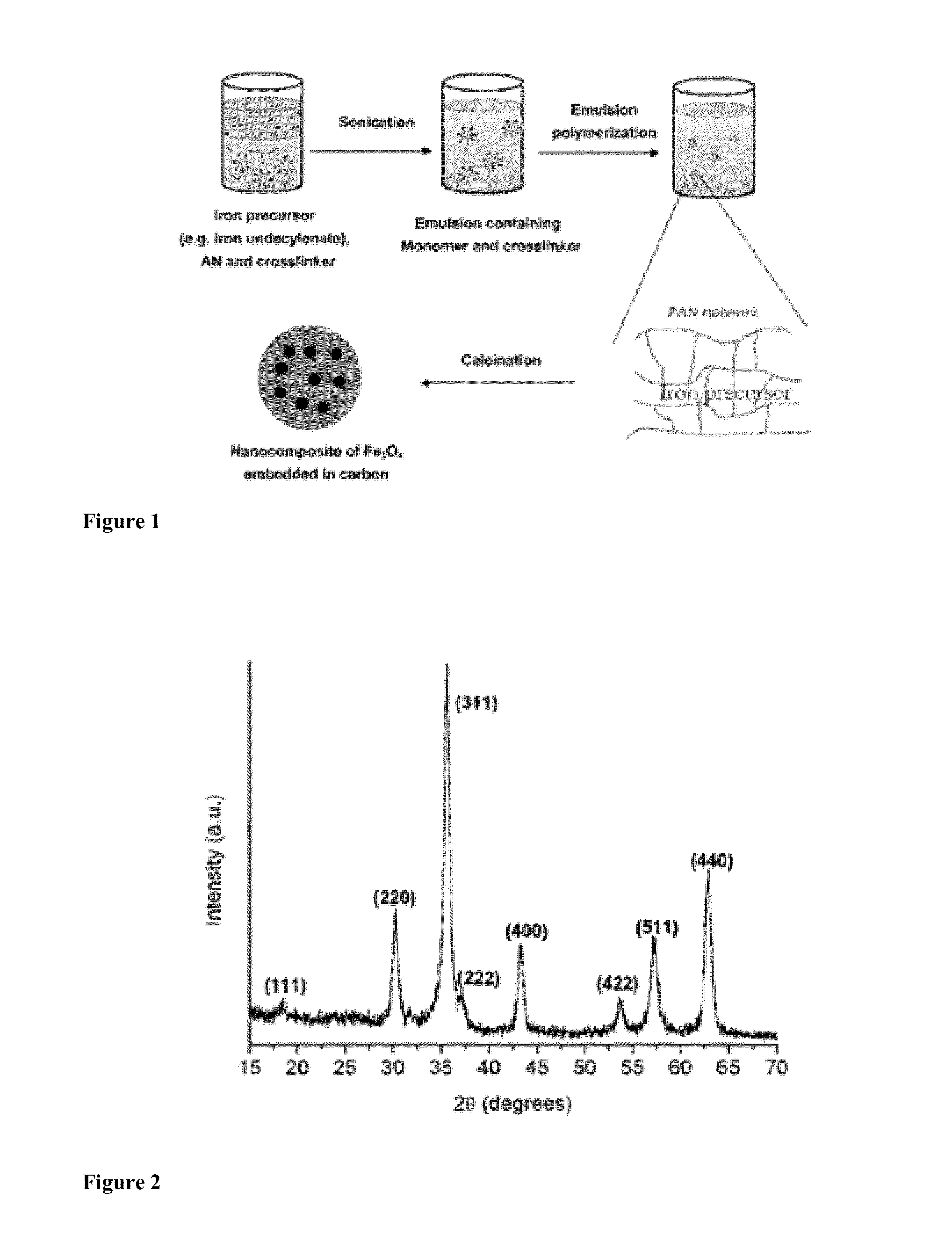Hybrid Materials and Nanocomposite Materials, Methods of Making Same, and Uses Thereof
a technology applied in the field of hybrid materials and nanocomposite materials, methods of making same, in situ formation of nanoparticles, etc., can solve the problems of performance achieved and cathode believed to be close to its limits
- Summary
- Abstract
- Description
- Claims
- Application Information
AI Technical Summary
Benefits of technology
Problems solved by technology
Method used
Image
Examples
example 1
[0133]This example describes the synthesis and characterization of examples of hybrid materials and nanocomposite materials of the present invention.
[0134]An in situ, scalable method for creating a variety of transition metal oxide-carbon nanocomposites was developed based on free-radical polymerization and cross-linking of poly(acrylonitrile) in the presence of the metal oxide precursor containing vinyl groups. The approach yields a cross-linked polymer network, which uniformly incorporates nanometer-sized transition metal oxide particles. Thermal treatment of the organic-inorganic hybrid material produces nearly monodisperse metal oxide nanoparticles uniformly embedded in a porous carbon matrix. Cyclic voltammetry and galvanostatic cycling electrochemical measurements in a lithium half-cell are used to evaluate the electrochemical properties of a Fe3O4-carbon composite created using this approach. These measurements reveal that when used as the anode in a lithium battery, the mate...
example 2
[0155]This example describes the synthesis and characterization of examples of hybrid materials and nanocomposite materials of the present invention.
[0156]Synthesis of LiFePO4@C nanocomposite. 108 mg LiOH, 221 mg H3PO4 and 660 mg L-ascorbic acid are dissolved in 10 ml DI water, to which 116 mg Fe3O4@C nanocomposite powder is added. The solution is loaded into a pressurized container and heated at 270° C. for 12 hr. The powder obtained is centrifuged and washed with water.
[0157]Synthesis of Mn0.75Fe0.25O@C nanocomposite. Manganese (II) undecylenate is synthesized using the same method as iron (III) undecylenate, with MnCl2 as the Mn precursor. 1.58 g manganese (II) undecylenate and 0.75 g iron (III) undecylenate are mixed to form a homogeneous mixture, and polymerization with acrylonitrile and divinylbenzene is performed using the same method as used for iron (III) undecylenate alone. The polymerization product is collected ant heat treated in the same way to obtain Mn0.75Fe0.25O@C n...
example 3
[0159]The synthesis, structural characterization and electrochemical performance of MoS2-carbon nanostructures is described in this example.
[0160]Composites of MoS2 and amorphous carbon were grown and self-assembled into hierarchical nanostructures via a hydrothermal method. Application of the composites as high-energy electrodes for rechargeable lithium-ion batteries was investigated. The critical roles of nanostructuring of MoS2 and carbon composition on lithium-ion battery performance are described. Pure MoS2 and 22 wt % carbon containing MoS2 materials are designated as MS-0 and MS-22 respectively.
[0161]Morphological investigations using SEM (FIG. 18a) reveal that the product obtained via the hydrothermal treatment of the molybdenum sol in presence of carbon precursors (resorcinol and formaldehyde) takes the form of open structure of MoS2 and carbon. The TEM images of MS-22 (22 wt % carbon), as shown in FIGS. 18b and c, indicate that MoS2 in the composites are in the form of sta...
PUM
| Property | Measurement | Unit |
|---|---|---|
| Percent by mass | aaaaa | aaaaa |
| Percent by mass | aaaaa | aaaaa |
| Diameter | aaaaa | aaaaa |
Abstract
Description
Claims
Application Information
 Login to View More
Login to View More - R&D
- Intellectual Property
- Life Sciences
- Materials
- Tech Scout
- Unparalleled Data Quality
- Higher Quality Content
- 60% Fewer Hallucinations
Browse by: Latest US Patents, China's latest patents, Technical Efficacy Thesaurus, Application Domain, Technology Topic, Popular Technical Reports.
© 2025 PatSnap. All rights reserved.Legal|Privacy policy|Modern Slavery Act Transparency Statement|Sitemap|About US| Contact US: help@patsnap.com



